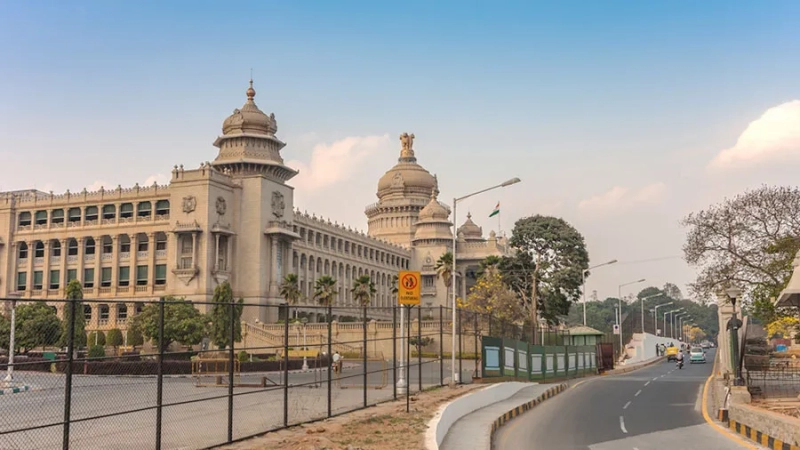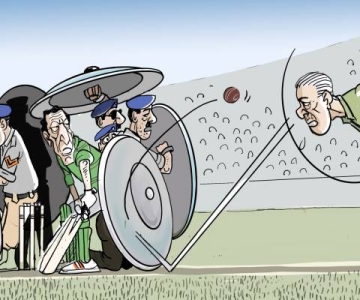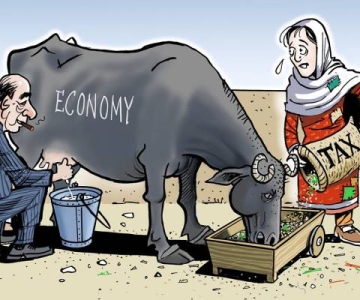In Part 3 of the series, I visited Bangalore, city of gardens and high tech
After our sojourns in Delhi and Mumbai, the Pakistani media representatives were afforded the opportunity to visit the fulcrum of shining India i.e. Bangalore, now rechristened as Bengaluru, its original name in Kannada. It was not difficult to guess why Bangalore is loved by so many across the globe. Its weather makes it a most unique city, somehow free of South Asian extremes in temperature. Weather aside, even the nature of its residents is fascinating, for it is palpably different from their North Indian counterparts. As we were to find out later, the distant conflicts of belligerent North India matter far less in the tropical climes of this congested yet verdant metropolis.
We were greeted at the airport by a contingent of security apparatchiks and the state police. The Bharatiya Janata Party (BJP) had planned country-wide protests over the increased fuel prices that were supposedly causing inflation and misery for the poor. The Pakistani delegation found itself amid a historical moment when the BJP was being backed by the communist parties of India in protesting over the reduction of state subsidies to keep the price of oil low. Hence, the tight security. As Karnataka is ruled by the BJP and regional parties, the strike was a great success, and we found the streets of Bangalore deserted.
The ITC Royal Gardenia Hotel where we stayed was simply stupendous. It had been recently built and was touted as a green haven for its adherence to environmental standards. Designed with an open plan sensibility, it had a feel of expanse and splendour. Special purpose vertical gardens had been created to augment the ambiance and blend nature with standard hotel architecture. However, life presents its little ironies, and one could not help notice the ITC (Indian Tobacco Company) ownership of this hotel chain. The corporate world knows well how to whitewash its minor sins and major profits.
Bangalore, lovingly nurtured as an archetypal British cantonment, has always been referred to as the City of Gardens. Its ecology helps create green spaces with plenty of rainfall per annum. However, Bangalore has also transformed over the years due to its emergence as an information technology (IT) hub. In many ways, the Indian IT success story, central to the India-shining narrative, is intertwined with Bangalore and its eminently hospitable mores. Among others, Infosys, a global giant conglomerate, grew and evolved in Bangalore. But there are other hubs too which make Bangalore a success story of contemporary India.
However, as we were told by many residents, development has come at a heavy price. The city is now a traffic nightmare, and gives an over-constructed look because of the large population. In spite of this account, we found Bangalore to be most charming. City roads were fairly empty on day two of our visit. Life returned to normal after five pm. By then we were at the Deccan Herald offices, where the editorial team interacted with us for a few hours (and later hosted a lovely dinner party at the Bangalore club) The most impressive part of our discussions was the congeniality and the willingness to understand Pakistan point of view. Representatives of the Deccan Herald’s sister publication Prajavani (a widely-circulated newspaper in Kannada) were also there.
We were quite candidly told that news on Pakistan had limited popularity in Bangalore, especially among the younger generation, as their concerns and priorities had changed due to the rapid growth that the state, especially Bangalore, had experienced in the past few decades. In terms of education, Bangalore leads the country with nationally acclaimed institutes like the Indian Institute of Management (IIM), National Institute of Design and the celebrated National Law School of India University. Even in terms of per capita income, Bangalore is among the top cities of the country. Kashmir, Mumbai and other fault lines between India and Pakistan were also discussed, but the tenor of the conversation was mild and conducive to unbiased communication.
There were a few Muslim women working as journalists in this media house. One of them, extremely bright and attractive, raised the issue of how the alleged acts of Islamic terror perpetrated by Pakistanis made things difficult for Muslims everywhere.
The other female staffers questioned us on the role and status of women in Pakistan, as their access to information on the country was limited, and subject to various stereotypes. Anjum Rahman of Express TV was quite articulate in giving a balanced view of the situation, and the other female member, Saeeda ji, of our delegation from the Business Recorder, Pakistan, provided a reasoned explanation of how Pakistan was a dynamic and complex country where cliches hardly made sense.
I added my little bit on the increased reporting of honour killings in India, and the uninformed debates on purdah which was dominating the headlines in the corporate media. For instance, how could one separate the veiled Rajasthani woman from a Muslim woman? Overall, this was a robust discussion. One editor even mentioned how removed the mainstream discourse was from the Partition saga and the Pakistan-centric worldview of the Punjab and its representatives in the ruling oligarchies of India.
After this meeting, we got a couple of hours to stroll around in the city centre. Half the shops remained shut despite the end of the strike. Shaukat Piracha and I walked a long way after crossing a lovely boulevard with blooming flame of the forest trees, and reached the commercial street. We had forty-five minutes before the deadline set by our hosts. So I had a quick chaat, a South Indian sweetmeat, and picked up cheap cotton clothes (before they were exported and sold in posh outlets abroad).
One could not help but notice the large number of Muslim residents in Bangalore. This was news to me as I found out that over a quarter of the city’s dwellers were of the Islamic faith. The brethren were discernible because of their tableeghi beards, and many women wore fastidious burqas. Earlier on the plane we had also met dozens of Bangalore Muslims who were returning from Umrah and had occupied two thirds of the seating space. At the time of take off, they even recited the appropriate Quranic verses which obviously unnerved a couple of passengers on the plane. Muslim stereotyping, especially on aircrafts, is now a global reality.
Asim Awan and I had decided to visit the Tableeghi markaz but we could not find the time. I also lost interest, for it was bound to be more of the same. Instead on the last day of our visit I visited a Sufi shrine with an internet friend of mine.
Fiza, a young intellectual, met me through the Pak Tea House blog that I set up a few years ago. These days she is associated with an alternative organization called ART., which works with students, academics, artists and art professionals. Through their workshops, ART promotes a composite arts pedagogy. Fiza took half her work-day off, and before we left for the airport gave me a city tour and showed me the delightful buildings of the colonial era.
We also had a traditional South Indian meal served on a banana leaf with hot accompaniments and an exceptionally well-cooked vegetables. But the high-point of this city tour was a visit to the most celebrated dargah of Bangalore. True to my leanings, I could not bring myself to visit the Tableeghi markaz despite the sociological interest in doing so. Instead, I landed in a dargah.
A saint of the Suhrawardi school of South Asian Sufism, Hazrat Tawakkal Masthan is also known as Bangalore Qutub (the highest station in Sufis). Nawab Hyder Ali is also linked to the saint, as Tawakkal was one of the pious labourers who worked as a menial labourer at Hyder Ali’s fort at Kalasipalya. Hyder Ali found out about these mysterious men who worked all day and worshiped all night and started to recognize their spiritual powers. Hyder Ali named his son Tipu after one of the saints.
A lovely mosque dated 1783 stands next to the dargah. As is always the case, oral histories are plural. Another version says that, Tawakkal Mastan, came from Iran as a trader and later gave up his business and found enlightenment in the Indian environment. There are curious amalgamations of Hindu and Muslim rites at the darghah.
I was surprised to find out that the dargah’s trust runs a computer institute, an English medium school, and a host of technical centres. Interestingly, Hindus and Christians also study at the schools. An avid devotee of Khwaja Muniuddin Chishty, the global icon A R Rahman also visits the dargah regularly. The dargah motifs and decoration were different from the other shrines I have visited in India.
Later, Fiza took me back into the folds of modernity. We stopped at another bookstore where we browsed through publications and connected with an array of people enjoying books. There we ended up presenting books to each other and said goodbyes. This was surreal a cyber figurine turning real.
Before my sightseeing ventures, our delegation was taken to Infosys which turned out to be another marvel of modern Bangalore. Built in the style of an American University, Infosys is less of a corporation and more of a campus. We were given a quick round and then introduced to the mega success story of the company which was started in 1981 by seven people with US$ 250. Today, it is a global leader in the next generation of IT and consulting, with revenues of over US$ 4.8 billion.
Its main areas of advice and design include business and technology consulting, application services, systems integration and product engineering, among other disciplines. The head of marketing who gave us the briefing has been teaching at MIT in the US and was a live wire because of his sharp understanding of not just his area of expertise but also of the world economy.
What is now termed as a global footprint is practiced by Infosys with sixty-three offices in India, China, Australia, the Czech Republic, Poland, the UK, Canada and Japan. By June 2010, Infosys and its subsidiaries had 114,822 employees.
This was an amazing insight into the rise of Indian entrepreneurship. If our relations were normal and we stopped reinventing our enmity, there is a lot that the two countries can learn from each other. Sadly, the list of Infosys offices does not include Pakistan.
Our responses on the occasion were measured, and inevitably the discussion came to politics and bilateral relations as well. Kamran Shahid as before ardently defended Pakistan’s national interest while others such as Dr Moeed Pirzada and Shaukat Piracha were keen to know more and more about the place. During the briefing we were served Western and South Indian delicacies and aromatic coffee for which South India is famous.
The tragedy of this first-ever visit to Bangalore was its short duration. Having said that, it is always better to have seen a city than never to have visited it. From Bangalore we were going back to Delhi to meet our High Commissioner and return to a home which was boiling in the wake of attacks on Data Darbar and blasts in Khyber-Pakhtunkhwa. Unfortunately, while the monsoons had started there were no signs or preparation for a disaster in the making the floods of July-August.
Before I sank into an evening nap on the plane, I could not help thinking about the way Bangalore has travelled in time. From a huge British cantonment it is now a global hub of the IT profession. Perhaps there was a lesson or two here for a nationalist Pakistani like myself.



